
The drum is a member of the percussion group of musical instruments. In the Hornbostel-Sachs classification system, it is a membranophone. Drums consist of at least one membrane, called a drumhead or drum skin, that is stretched over a shell and struck, either directly with the player's hands, or with a percussion mallet, to produce sound. There is usually a resonant head on the underside of the drum. Other techniques have been used to cause drums to make sound, such as the thumb roll. Drums are the world's oldest and most ubiquitous musical instruments, and the basic design has remained virtually unchanged for thousands of years.

The tambourine is a musical instrument in the percussion family consisting of a frame, often of wood or plastic, with pairs of small metal jingles, called "zills". Classically the term tambourine denotes an instrument with a drumhead, though some variants may not have a head. Tambourines are often used with regular percussion sets. They can be mounted, for example on a stand as part of a drum kit, or they can be held in the hand and played by tapping, hitting, or shaking the instrument.
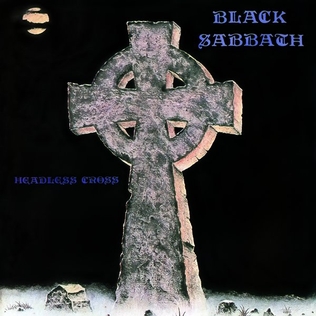
Headless Cross is the fourteenth studio album by English heavy metal band Black Sabbath. Released in April 1989, it was the group's second album to feature singer Tony Martin, the first to feature drummer Cozy Powell, and the only album with session bassist Laurence Cottle.

Daf, also known as dâyere and riq, is a Middle Eastern frame drum musical instrument, used in popular and classical music in South and Central Asia. It is also used in Afghanistan, Azerbaijan, Tajikistan, Iran, Uzbekistan, many regions of Georgia, Armenia, Pakistan as well as in parts of India and Russian polar regions. It is also popular among Balkans, Caucasians, Bukharan Jews, Kurds, and Macedonians.

The conga, also known as tumbadora, is a tall, narrow, single-headed drum from Cuba. Congas are staved like barrels and classified into three types: quinto, tres dos or tres golpes (middle), and tumba or salidor (lowest). Congas were originally used in Afro-Cuban music genres such as conga and rumba, where each drummer would play a single drum. Following numerous innovations in conga drumming and construction during the mid-20th century, as well as its internationalization, it became increasingly common for drummers to play two or three drums. Congas have become a popular instrument in many forms of Latin music such as son, descarga, Afro-Cuban jazz, salsa, songo, merengue and Latin rock.

"Mr. Tambourine Man" is a song written by Bob Dylan, released as the first track of the acoustic side of his March 1965 album Bringing It All Back Home. The song's popularity led to Dylan recording it live many times, and it has been included in multiple compilation albums. It has been translated into other languages and has been used or referenced in television shows, films, and books.

Mike the Headless Chicken was a male Wyandotte chicken that lived for 18 months after he was beheaded, surviving because most of his brain stem remained intact and it did not bleed to death due to a blood clot. After the beheading, Mike achieved national fame until his death in March 1947. In Fruita, Colorado, United States, an annual "Mike the Headless Chicken Day" is held in May. Mike has the record for the longest surviving chicken without a head on Guinness World Records.

The Dullahan is a type of legendary creature in Irish folklore. He is depicted as a headless rider on a black horse, or as a coachman, who carries his own head. As it is not widely attested in native sources, including no references to it on the Irish Folklore Commission's website, there is doubt as to whether the Dullahan was originally a part of the Irish oral tradition.

Harold Eugene Clark was an American singer-songwriter and founding member of the folk rock band the Byrds. He was the Byrds' principal songwriter between 1964 and early 1966, writing most of the band's best-known originals from this period, including "I'll Feel a Whole Lot Better", "She Don't Care About Time", "Eight Miles High" and "Set You Free This Time". Although he did not achieve commercial success as a solo artist, Clark was in the vanguard of popular music during much of his career, prefiguring developments in such disparate subgenres as psychedelic rock, baroque pop, newgrass, country rock, and alternative country. He was inducted into the Rock and Roll Hall of Fame in 1991 as a member of the Byrds.

The khol is a terracotta two-sided drum used in northern and eastern India for accompaniment with devotional music (bhakti). It is also known as a mridanga, not to be confused with mridangam. It originates from the Indian states of Odisha, West Bengal, Assam and Manipur. The drum is played with palms and fingers of both hands.
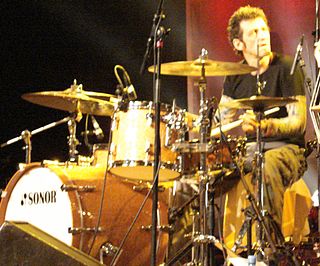
Sergé "Jojo" Mayer is a Swiss drummer born in Zürich and currently residing in New York City.
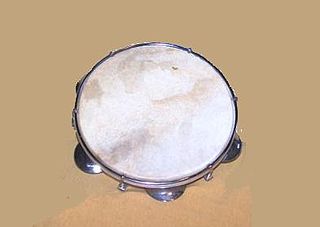
The pandeiro is a type of hand frame drum popular in Brazil. The pandeiro is used in a number of Brazilian music forms, such as samba, choro, coco, and capoeira music.
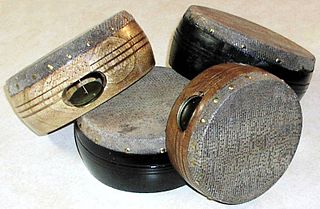
The kanjira, khanjira, khanjiri or ganjira, a South Indian frame drum, is an instrument of the tambourine family. As a folk and bhajan instrument, it has been used in the Indian subcontinent for many centuries.
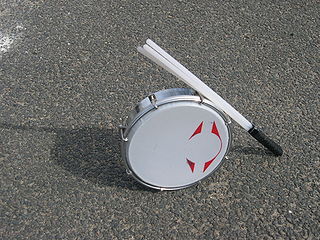
A tamborim is a small round Brazilian frame drum, developed from other similar percussive instruments brought by the Portuguese.

The tsudzumi (鼓) or tsuzumi is a hand drum of Japanese origin. It consists of a wooden body shaped like an hourglass, and it is taut, with two drum heads with cords that can be squeezed or released to increase or decrease the tension of the heads respectively. This mechanism allows the player to raise or lower the pitch of the drum while playing, not unlike the African talking drum and the Indian dhadd.

Remo Inc. is an American musical instruments manufacturing company based in Valencia, California, and founded by Remo Belli in 1957. Products manufactured include drum kits, drumheads, drums, and hardware, and various percussion instruments.

A frame drum is a drum that has a drumhead width greater than its depth. It is one of the most ancient musical instruments, and perhaps the first drum to be invented. It has a single drumhead that is usually made of rawhide, but man-made materials may also be used. Some frame drums have mechanical tuning, while on many others the drumhead is tacked in place. The drumhead is stretched over a round, wooden frame called a shell. The shell is traditionally constructed of rosewood, oak, ash etc. that has been bent and then scarf jointed together; though some are also made of plywood or man-made materials. Metal rings or jingles may also be attached to the frame. In many cultures larger frame drums are played mainly by men in spiritual ceremonies, while medium-size drums are played mainly by women.

The bodhrán is a frame drum used in Irish music ranging from 25 to 65 cm (10–26 in) in diameter, with most drums measuring 35–45 cm (14–18 in). The sides of the drum are 9–20 cm deep. A goatskin head is tacked to one side. The other side is open-ended for one hand to be placed against the inside of the drum head to control the pitch and timbre.

The Headless Horseman is an archetype of mythical figure that has appeared in folklore around Europe since the Middle Ages. The figures are traditionally depicted as riders upon horseback who are missing their heads. These myths have since inspired a number of stories and characters in popular culture, including "The Legend of Sleepy Hollow".

Kidskin or kid leather is a type of soft, thin leather that is traditionally used for gloves. It is widely used for other fashion purposes such as footwear and clothing. Kidskin is traditionally made from goatskin – more specifically, the skin of young goats, although equivalent leathers such as lambskin and chickenskin give the same effect.




















